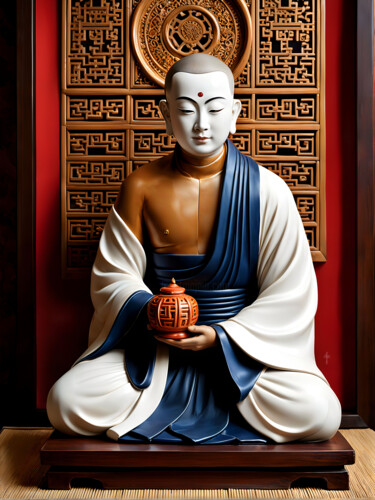Daniel Arrhakis
In a society in crisis of values, even Beauty is no longer artistic...
2 artworks by Daniel Arrhakis (Selection)
Download as PDFJapanese Dolls, wooden Boxes and Sculptures : Gogatsu , Gogatsu Ningyo, Kyo Ningyo, • 2 artworks
The history of Japanese dolls dates back to the clay figures of the Jomon era and burial-mound figures [...]
The history of Japanese dolls dates back to the clay figures of the Jomon era and burial-mound figures of the Kofun era. Evidence shows that these figures were employed in religious rituals and black magic.
Kyoto dolls (kyo-ningyo) became popular during the Heian Period, when they were thought to bring luck and health to children.
In the latter half of the Edo period (18th to 19th centuries), the "Gosho doll", which depicts a cute, plump baby figure, was used as a gift from the court to various feudal lords. These traditions of doll making continue up to the present day.
Gogatsu Ningyo literally translated as "May Dolls", is a Warrior Doll for boys displayed in Japanese houses in the honor of the household's newborn sons. It symbolizes courage and power, used in hope of good fortune and protecting the children from diseases and evil.
Ningyō (lit. “human form”) are one of the traditional Japanese crafts. The meaning tied to these dolls is why they were called "human figures" or "substitutes". During the Heian era, dolls and other forms of human figures were sacrificed as effigies in order to drive away disease and bad luck. The custom of Nagashi Bina, or floating paper dolls downriver in the hope of washing away impurities, continues today in some parts of Japan.
Gradually, these “human figures” were dissociated with the customs and rituals of casting spells and became toys for young girls.
In this series the artist explores this idea in sculptures and portraits of Geisha, Samurais, Young Buddhist monks, Old Wise Men, in a more realistic form, in a wooden ornate box , in a Shadow Box, in a background mystic and symbolic or in an architectural Japanese traditional vision that remember that ancient dolls and porcelain sculptures .
Kyoto dolls (kyo-ningyo) became popular during the Heian Period, when they were thought to bring luck and health to children.
In the latter half of the Edo period (18th to 19th centuries), the "Gosho doll", which depicts a cute, plump baby figure, was used as a gift from the court to various feudal lords. These traditions of doll making continue up to the present day.
Gogatsu Ningyo literally translated as "May Dolls", is a Warrior Doll for boys displayed in Japanese houses in the honor of the household's newborn sons. It symbolizes courage and power, used in hope of good fortune and protecting the children from diseases and evil.
Ningyō (lit. “human form”) are one of the traditional Japanese crafts. The meaning tied to these dolls is why they were called "human figures" or "substitutes". During the Heian era, dolls and other forms of human figures were sacrificed as effigies in order to drive away disease and bad luck. The custom of Nagashi Bina, or floating paper dolls downriver in the hope of washing away impurities, continues today in some parts of Japan.
Gradually, these “human figures” were dissociated with the customs and rituals of casting spells and became toys for young girls.
In this series the artist explores this idea in sculptures and portraits of Geisha, Samurais, Young Buddhist monks, Old Wise Men, in a more realistic form, in a wooden ornate box , in a Shadow Box, in a background mystic and symbolic or in an architectural Japanese traditional vision that remember that ancient dolls and porcelain sculptures .
"The Japanese Sculpture Monk Box"
Available
from $31.25
Daniel Arrhakis
"Shadow Box Portrait Of A Samurai - Akira"
Digital Arts | Several sizes
Available
from $31.25
Contact Daniel Arrhakis
Send a private message to Daniel Arrhakis










